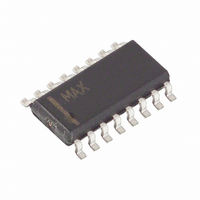MAX797CSE+T Maxim Integrated Products, MAX797CSE+T Datasheet - Page 19

MAX797CSE+T
Manufacturer Part Number
MAX797CSE+T
Description
IC CNTRLR STEP DOWN 16-SOIC
Manufacturer
Maxim Integrated Products
Type
Step-Down (Buck)r
Datasheet
1.MAX797CSE.pdf
(32 pages)
Specifications of MAX797CSE+T
Internal Switch(s)
No
Synchronous Rectifier
Yes
Number Of Outputs
2
Voltage - Output
3.3V, 5V, Adj
Current - Output
10A
Frequency - Switching
150kHz, 300kHz
Voltage - Input
4.5 ~ 30 V
Operating Temperature
0°C ~ 70°C
Mounting Type
Surface Mount
Package / Case
16-SOIC (3.9mm Width)
Power - Output
696mW
Lead Free Status / RoHS Status
Lead free / RoHS Compliant
The five pre-designed standard application circuits
(Figure 1 and Table 1) contain ready-to-use solutions
for common applications. Use the following design pro-
cedure to optimize the basic schematic for different
voltage or current requirements. Before beginning a
design, firmly establish the following:
V
value should include the worst-case conditions, such
as no-load operation when a battery charger or AC
adapter is connected but no battery is installed.
V
determined by the breakdown voltage of the BST float-
ing gate driver to GND (36V absolute maximum).
V
should be taken at full-load under the lowest battery
conditions. If V
must be used to externally hold up VL above 4.8V. If
the minimum input-output difference is less than 1.5V,
the filter capacitance required to maintain good AC
load regulation increases.
Figure 9. Secondary-Output Feedback Dividers, MAX796 vs. MAX799
IN(MAX)
IN(MAX)
IN(MIN)
_________________Design Procedure
1-SHOT
TRIG
MAX796
+V
, the minimum input (battery) voltage. This
, the maximum input (battery) voltage. This
must not exceed 30V. This 30V upper limit is
TRIP
2.505V REF
= V
SECFB
REF
DH
DL
IN(MIN)
(
1 + –––
______________________________________________________________________________________
R2
R3
V+
is less than 4.5V, a special circuit
)
Synchronous Rectifier for CPU Power
WHERE V
REF
(NOMINAL) = 2.505V
R3
R2
POSITIVE
SECONDARY
OUTPUT
MAIN
OUTPUT
Step-Down Controllers with
The exact inductor value isn’t critical and can be
adjusted freely in order to make tradeoffs among size,
cost, and efficiency. Although lower inductor values will
minimize size and cost, they will also reduce efficiency
due to higher peak currents. To permit use of the physi-
cally smallest inductor, lower the inductance until the
circuit is operating at the border between continuous
and discontinuous modes. Reducing the inductor value
even further, below this crossover point, results in dis-
continuous-conduction operation even at full load. This
helps reduce output filter capacitance requirements but
causes the core energy storage requirements to
increase again. On the other hand, higher inductor val-
ues will increase efficiency, but at some point resistive
losses due to extra turns of wire will exceed the benefit
gained from lower AC current levels. Also, high induc-
tor values can affect load-transient response; see the
V
The following equations are given for continuous-con-
duction operation since the MAX796 is mainly intended
for high-efficiency battery-powered applications. See
Appendix A in Maxim’s Battery Management and DC-
DC Converter Circuit Collection for crossover point and
discontinuous-mode equations. Discontinuous conduc-
tion doesn’t affect normal idle-mode operation.
SAG
1-SHOT
TRIG
0.33µF
equation in the Low-Voltage Operation section.
MAX799
-V
TRIP
REF
= -V
SECFB
REF
DH
DL
(
–––
R2
R3
)
V+
R3 = 100kΩ (RECOMMENDED)
R3
R2
Inductor Value
NEGATIVE
SECONDARY
OUTPUT
MAIN
OUTPUT
19











